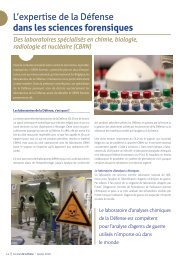Institute
XiXCVS
XiXCVS
You also want an ePaper? Increase the reach of your titles
YUMPU automatically turns print PDFs into web optimized ePapers that Google loves.
The principal hypothesis of this Focus Paper is that the EU has set forth on a stealth<br />
path to strengthen the EU’s defence industrial base: by calling for and prioritizing militarygrade<br />
or civilian drone research; and, more recently, by benefiting from dual-use technologies<br />
and dual-use research and production projects. Is the hybridization of R&D research for<br />
civilian-military capabilities the EU’s clever strategy to avoid the Treaties’ restrictions on<br />
using the massive Structural Funds (SF) for strictly military purposes? This interpretation<br />
rings true; the EU aims to boost the European defence industry by funding for civilianmilitary<br />
R&D under FP7, Horizon2020 or COSME programmes. Or is this yet again another<br />
EU-level form of escapism from developing strictly speaking hard military capabilities?<br />
There are indicative examples of a pan-European hybrid drone development trend,<br />
favouring large security and defence companies and a club of select and powerful dronedeveloping<br />
EU Member States. Moreover, regulatory safeguards for airworthiness and air<br />
traffic management (ATM) programmes are being pushed forward for the safe insertion of<br />
military aircrafts and drones in the civilian airspace. The study will also tackle the main<br />
initiatives and projects at the EU-level responsible with the RPAS’ air traffic insertion that<br />
must be put in place to ensure the technical safety and the safe operation of RPAS in civilian<br />
and commercial airspace.<br />
To paraphrase the expression ‘everywhere in [Europe, [man] remain[s] unfree and<br />
chained to technology’ from Heidegger’s ‘The Question Concerning Technology’ 20 , the<br />
situation in the EU concerning RPAS development could spell worrying scenarios. The more<br />
this type of technology advances, the more it ‘threatens to slip from human control’ 21 or, in<br />
this case, from democratic control.<br />
More critical thought should be given to the choice for prioritising dual-use<br />
technologies to bolster the European defence market to preserve the EU’s security autonomy<br />
in the future. Issues pertaining to democratic accountability and oversight will be addressed<br />
in the research, especially concerning the role of the European Parliament. How removed is<br />
the European defence policy from the authority of national parliaments, the European<br />
Parliament, or public opinion accountability?<br />
The EU decision-makers have been under lobbying pressures from powerful arms<br />
corporations, 22 with the increasing tendency to denationalize military industries and<br />
streamline a more cost-effective, competitive and technologically superior pan-European<br />
arms industry. Three big EU-based arms-producing companies, such as the Airbus Group<br />
(ex-EADS), BAE Systems and Thales, are some of the major players in the field and assert<br />
their own agenda and strategic interest in the European defence policy realm. 23<br />
National Defence Technological and Industrial Bases (DTIBs) in Europe have come<br />
under increased pressures to produce competitive defence capabilities, due to budgetary<br />
restrictions and defence market forces. 24 there is no denying the fact that the centre of gravity<br />
for defence technology R&D and innovation has shifted from defence to the civilian sector 25<br />
20 M. Heidegger, The Question Concerning Technology and Other Essays (New York & London: Garland<br />
Publishing Inc., 1977): 287.<br />
21 Ibidem, 289.<br />
22 D. Fiott, ‘EADS, BAE Systems and the future of European armaments cooperation,’ European Geostrategy,<br />
April 2, 2013. Accessed September 25, 2015. http://www.europeangeostrategy.org/2013/04/eads-futurearmaments-cooperation/<br />
23 Ibidem<br />
24 D. Fiott, ‘The European Defence Technological and Industrial Base: Five Suggestions’ in ‘The State of<br />
Defence in Europe: State of Emergency?,’ EGMONT PAPER 62 (ACADEMIA PRESS, November 2013): 73-<br />
74.<br />
25 M. Penny, T. Hellgren, & Matt Bassford, ‘Future Technology Landscape: Insights, analysis and implications<br />
for defence,’ RAND Europe, December 5, 2013. Accessed September 25, 2015



